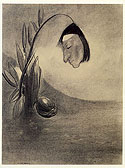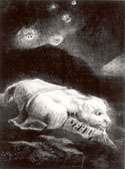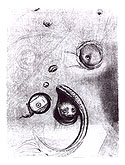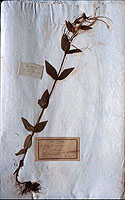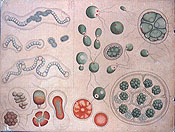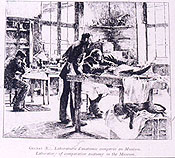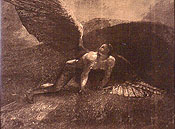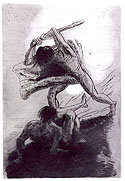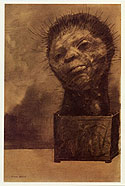The browser will either open the file, download it, or display a dialog.
|
|
Evolution and Degeneration in the Early Work of Odilon Redon |
||||||||||
|
Odilon Redon's graphic work of the last quarter of the nineteenth century includes many examples of mutating or hybrid forms that are informed by transformisme: fish-men, plants with human faces, and ape-men among them. (fig. 1) His lithographic series Origins, 1883, deals explicitly with evolutionary theory, exploring the theme of man's development from single cells and an embryological fish-animal-humanoid form which skims the ocean floor in the first print to a lumbering human figure in the final print.1 While Redon's primary influence came from Darwin, there are several strains of evolutionism and related biological theories referred to in his work. In order to better understand his hybrid imagery, the complex scientific climate of late nineteenth-century France needs to be elaborated, and the various strands of evolutionism untangled. The macabre universe he evokes in his early works is also related to a dark philosophical specter that emerged in the shadow of evolutionary theory, the possibility of decline or degeneration. This powerful, circulating discourse played on national anxieties in a country that had recently lost the Franco-Prussian War only to face the bloody internal conflict of the Commune which followed. | ||||||||||
| Redon's interest in evolution and degeneration developed against the backdrop of the anti-clerical early Third Republic, which promoted progressive science as the way out for a defeated nation. By the 1880s, when many of Redon's biological noirs were produced, Paris was credited with being the most active center of biology in the world. The study of the material aspects of man's nature emerged as one of the principal focuses of scientific investigation of the post-war period. "Evolution" and all that it suggested about man's place in the natural scheme of things was the unifying concept under which new research was undertaken: man's biological past, the origins of his thought, and the adaptive purposes behind his skeletal and nervous system were all analyzed under the authority of evolutionary theory. Yet the scientific community was divided between diverging models of evolution: while many remained devoted followers of the earlier theories of French scientist Jean-Baptiste Lamarck, others supported the more recent writings of Darwin. The community was further fragmented, of course, between supporters and opponents of evolution. Redon's hybrid forms, which he fondly referred to as his "monsters" emerged out of the debate around evolutionary theory. | |||||||||||
| During the mid-1870s, Redon took advantage of the many free lectures offered to the public by scientific institutions. He noted the importance of time spent at the Faculty of Medicine in Paris and the lectures on osteology he attended there, as well as his investigations into comparative anatomy at the Museum of Natural History, an institution that sponsored a range of public courses in the natural sciences.2 The Museum of Natural History had long been entrenched in the reputation of the anti-evolutionist Georges Cuvier whose hall of comparative anatomy remained largely untouched when Redon was frequenting it. Cuvier was the first to systematically reconstruct fossil vertebrates and founded the field of vertebrate paleontology at the end of the eighteenth century. While Cuvier upheld the theory of successive deluges and believed in the separation and fixity of species, his classifications demonstrated the relationship of skeletal structures through time as well as a principle of correlation of parts to the whole that established the unity and harmony of a single animal. Of Redon's anatomical hybrids, his original biographer André Mellerio would note, "It was at the museum that he grasped Cuvier's great law regarding the correspondence of being."3 Despite the scientist's formidable legacy, the great debate over evolutionary theory had overtaken the museum's staff by the mid-seventies. Redon would also have been familiar with another museum collection that featured comparative anatomy. Paul Broca, founder of the French school of anthropology, established the École d'anthropologie at the Faculty of Medicine in 1876; here, he opened a museum of comparative anatomy and offered a series of public lectures on the topic beginning in 1877.4 Scientists compared and dissected cadavers of humans from various parts of the world along with primates at this museum in the great quest for origins. | |||||||||||
|
Redon's anatomical monstrosities such as the creature in "When life was awakening in the depths of obscure matter" from Origins may have been influenced by Etienne Geoffroy Saint-Hilaire, an early nineteenth-century scientist whose work was enjoying a revival in the seventies since he was seen as a precursor to evolutionary theorists. (fig. 2) Geoffroy Saint-Hilaire had believed that a single skeletal type pervaded nature and he searched for intermediary creatures between kingdoms, yet never developed a consistent evolutionary mechanism.5 Asked in an interview what his favorite works were, Redon responded, "My monsters. I believe that it is there that I have given my most personal note. I worked and studied a great deal on anatomy to arrive at the conclusion that everything is man—in every living being one finds under individual forms the lines of the human skeleton. It is with this principle in mind that I deformed, made larger or simplified an aspect of my embryonic beings. If any part of my work should last I believe that it should be my monsters."6 Further, he brought up Geoffroy Saint-Hilaire's "law of compensation" in relationship to his hybrids. Redon put it this way: "Any exaggeration of one part involves the diminution of another, in a word, the equilibrium is broken or compensated for in another way. Thus, an enormous head with a small body and vice versa."7 | ||||||||||
|
|
|||||||||||
|
Redon's descriptions of his fantastic hybrid forms as "monsters" suggests another point of influence from Geoffroy Saint-Hilaire, for the scientist had established the science of teratology or monstrosities in the 1830s. In his famous treatises General Considerations on Monsters and The Human Monster the scientist asserted that embryonic deviations from the norm reveal true biological secrets and can offer insight into catalysts behind evolution. In the 1870s (and today as well), the hall of comparative anatomy at Paris's Museum of Natural History included not only animal and human skeletons and skulls, but a vitrine of biological, monstrous human embryos, fetuses and defective newborns. Geoffroy Saint-Hilaire is also known as the father of embryology. In his research on "monstrosities," he put forth the idea that the human fetus follows the evolution of the entire animal kingdom from the single-celled to the gill-breathing to the vertebrate to man with errors in development possible along the way. He even believed that if he intervened in fetal development he could arrest the embryo at a fish or animal stage. This theory of recapitulation was further refined in the 1870s by the evolutionary theorist Ernst Haeckel, who also interested Redon. A number of Redon's imaginative images such as "That Eyes Without Heads Were Floating Like Mollusks" from the Temptation of St. Anthony series of 1896 directly reflect embryology, while the theory, so popular in the late nineteenth century, is strongly implied in the hybrids. (fig. 3) | ||||||||||
|
Redon was above all a Darwinist. Mellerio noted the artist's interest in Darwin along with his German follower in his biography of 1913.8 In the introductory catalogue essay of Redon's first retrospective exhibition in 1894, Mellerio had already written of "l'épopée darwinienne" which inspired the artist. Redon's interest in Darwin began when he was a young landscape artist in Bordeaux in the early 1860s and made the acquaintance of the plant physiologist who would become his intellectual mentor—Armand Clavaud. As a Darwinist when On the Origin of Species was making a great impact on botany, Clavaud studied diverse populations and the plant's relationship to the environment, which was key in understanding the mechanism of natural selection applied to plant life. According to Darwin's description of natural selection, "As many more individuals of each species are born than can possibly survive, and as, consequently, there is a frequently recurring struggle for existence, it follows that any being, if it varies however slightly in any manner profitable to itself, under the complex and sometimes varying conditions of life, will have a better chance of surviving and thus be naturally selected."9 By the 1860s, plants were thought of as engaged in a struggle to survive that had effected their external forms and internal structures. Clavaud gathered samples of plant varieties from the local Gironde region and as far away as Australia, compiling them in dozens of volumes, which are still conserved at the Jardin Botanique in Bordeaux. (fig. 4) Redon recalled often seeing Clavaud at work on his herbaria. As a physiologist, Clavaud studied reproductive and other life processes of various plants and flowers. He was a gifted illustrator and, in the 1870s and 1880s when Redon was creating his botanical noirs, the scientist was carefully transcribing his microscopic observations to large plates to be used for teaching purposes. (fig. 5) | ||||||||||
| Partly the result of Darwin's influence on the subject of structural adaptation, plant physiology became a separate field of investigation within botany by the 1860s. At the same time, advances in the microscope allowed for the discovery that animal cell matter or "sarcode" was virtually identical to plant cell matter or "protoplasm," suggesting a combined original basis for both kingdoms. This discovery revolutionized research and the search for intermediary forms between kingdoms was widespread. Animals and plants were now found to have similarities in respiration, nutrition and metabolic processes. Plants were even described as having organs and were credited with the power of response, sensitivity to their surroundings and perhaps some sort of primitive feeling. These ideas were popularized in books like Noel's La Vie des fleurs of 1863 or Grimard's La Plante of 1865. Clavaud also engaged in such metaphysical speculations over plant life. For this imaginative botanist, each plant had its own individual life. Even in his official obituary in the Actes de la Société Linnéenne de Bordeaux of 1890, it was noted, "Clavaud was not interested in banal listings of characteristics. He was fascinated by individual attributes of plants—each having its own living personality."10 |
|||||||||||
|
|
|||||||||||
| Clavaud's Darwinism was inflected with a spiritualist belief in the interconnectedness of all living things that derived from German Naturphilosophie, and this merging of the spiritual and material would manifest itself in Redon's work.11 It was Clavaud who introduced Redon to Hindu and Buddhist literature as well as to the literature of nature mysticism. His interest in idealism, pantheism, the possibility of an underlying universal harmony, and awe before the mysteries of nature, provided Redon with a philosophical model—one where the latest advances of science did not preclude the realm of the imagination or spirit. In the 1890s, when Darwinian theory was under pressure by those seeking to assert the importance of religion, Redon would return to these and other sources in an effort to combine his scientism with a spiritual path that did not necessarily reject natural processes. Clavaud's continuing importance in Redon's life is reflected in the statement of 1883, "Je pense souvent à lui, meme par lui."12 | |||||||||||
|
For Redon, the most important aspect of Clavaud's work was his research on certain types of algae. Clavaud's first publication of 1859 was on an algae from the Characeae family; a later more widely distributed booklet by Clavaud on algae, Sur le Nitella Stelligera des auteurs, was published in 1864. Redon would say of this work, "He worked with the infintely small. He searched. . .at the edge of the imperceptible world, for that life which lies between plant and animal. . .this mysterious element which is animal being a few hours a day and only under the effects of light."13 Redon's many combined animal-plant forms allude to this work. The search for life forms that might be able to shed light on "origins," in this case through an organism that had shared animal and plant properties, became one of the great quests of the 1860s. The fascination with certain forms of algae by scientist and the lay public alike was such that it was even referred to in Jules Michelet's Le Montagne (1868): "In marshes there are some plants which, in the warm light, become animal for four hours a day and then, when the day declines, resume a vegetable existence, but the quality of the two lives, the vegetable and the animal, is most plainly seen at the divine moment of love. Such flowers rise to the level of the highest animals through love, through love the plant makes itself man."14 In 1909 Redon would write to the collector Bonger:
Redon's many combined plant-man forms allude to this new field of study. |
|||||||||||
| Redon's interest in Darwin, even before his theories had been widely popularized in France, would have been encouraged in another context during the decade of the 1860s. In 1864 Redon left Bordeaux to study at the École des Beaux Arts in Paris. Following curricula reforms in 1863, science was admitted for the first time. Louis Pasteur was named to the newly created chair of geology, chemistry and physics in 1864. At the same time, the naturalist philosopher Hippolyte Taine was appointed Professor of Aesthetics. This influential theorist was a Darwinist and much admired by Clavaud. Taine's famous dictum "race-milieu-moment," which held that the spirit and form of a people reflect the environment and time period in which they are found, was part of his theory of aesthetics: the art of various countries and periods should be understood as the product of specific environmental circumstances. He gave the following explanation to artists when Redon was at the École des Beaux Arts: "Physical temperature acts by elimination and suppression—in other words, natural selection. Such is the great law by which we now explain the origin and structure of diverse existing organisms—a law as applicable to moral and physical conditions, to history as well as to botany and zoology, to genius and character as well as to plant and animal. In short there is a moral temperature, consisting of the general state of mind and manners—a moral temperature which makes a selection among different species of talent to the exclusion of others."16 | |||||||||||
| Following this logic, Taine reasoned that the kind of art produced in an age of misery, depopulation or decadence should, ideally, be an art of melancholy. The artist should feel aggravated by his conditions and exaggerate these sentiments. He advocated using darker colors than usual and felt that the viewer would be more responsive. He remarked, "If you place a man who has lost his health before a Rubens he will turn away and face the works of Rembrandt."17 Rembrandt was one of Redon's favorite artists. The humanity of Redon's post-war work, the selection of the predominance of black and chiaroscuro in his noirs, along with printmaking as a primary medium would owe a great deal to the old master's example as well as to Taine's theories. Regarding his coming of age during the Franco-Prussian War, Redon remarked, "Of all the moral situations for art or thought there is none more fertile than great patriotic sorrow."18 The anxieties of a defeated nation provided Redon with the subject matter and dark-spirited mood that would characterize many of the charcoals and lithographs of the next two decades. By basing his mature works in the war and its aftermath, he followed Taine's advice to respond to "the moral temperature of the times." The philosopher's instruction to use the natural sciences and evolutionary theory to analyze the features of society gave Redon the direction he would need to explore "the sentiments of the age." | |||||||||||
| After the events of 1870–71 the pessimistic currents of determinism already making themselves felt with uniformitarian geology, physiology and evolutionary theory, were reinforced by the publication of Darwin's The Descent of Man in 1871.19 In this work, the continuity between man's complex human faculties and their animal ancestry was firmly established. Here, Darwin made explicit what he had only hinted at up to this point: that man's immediate ancestor was a "hairy, tailed arboreal creature." Man was dethroned from his place at the top of a neatly ascending evolutionary ladder (with its implications of humanity as a lesser reflection of God himself), as had been posited by Darwin's predecessor Lamarck. Rather, he was as much a product of heredity, adaptation and struggle for existence as were species of plants and animals. Man was, in short, the result of natural selection. Further, in The Descent Darwin spoke of man's ever present "homologies with lower animals—the rudiments which he retains and the reversion to which he is liable."20 Darwin's mechanism of natural selection, which provided an explanation for the survival of some species and the demise of others, along with his warnings about the possibility of reversion, made evolution an unstable and unpredictable process. | |||||||||||
| The Museum of Natural History remained too conservative an institution to fully embrace Darwinism in the 1870s and upheld instead Lamarck's ladder-like theory of evolution, which had a great deal of appeal because it was based on the notion of progress. Lamarckian theory would find favor at the museum until well into the 1890s. Still, the museum's role in the great quest for man's origins was significant. The 1888 salon painting The Laboratory of Comparative Anatomy at the Museum, by Gelhay, with a primate featured prominently in the foreground, reveals public awareness of the institution's role in the examination of man's relationship to his simian kin. (fig. 6) In 1887, Emmanuel Frémiet, drawing master at the museum, won a medal of honor at the salon with his Gorilla Carrying Off a Woman, a subject considered to be still too controversial when his first version of this subject was rejected from the salon of 1859. | |||||||||||
| Despite a certain nationalist resistance to Darwin and an early post-war preference for Lamarck, by the mid-1880s Darwinism had emerged as the major philosophical underpinning of the natural sciences, and the theory's conception of man's place in the natural world had reverberations for a defeated nation. With little room for deity in the Darwinian universe, the notion of the immortal soul was cast into doubt: man was related to the ape, not to the angel. This displacement of man from the center of creation, converging with the waning importance of France, would have numerous echoes in Redon's work, beginning with the fallen angels of the immediate post-war period. (fig. 7) Redon's corporeal fallen angels have lost their divine status. Darkly pensive or sullenly looking back toward the heavens, they are earth-bound fated mortals, with thoughts imprisoned in their material existence. | |||||||||||
|
Redon's response to the contemporary fascination with man's emergence from his animal past is complex and often tinged with irony. His Centaur Taking Aim at the Clouds of the mid-1870s presents a creature with a square, simian face and receding forehead that ties the figure to its base animal origins (Museum of Modern Art, New York). Using a bow as a hunting tool, he is, nevertheless, prehistoric man. Taking aim towards an indeterminate point in the heavens, he is also a dreamer. Redon's interest in the origins of human thought or awakening consciousness, and the ultimate tragedy of humanity caught in nature's deterministic framework is suggested in the half-beast, half-man creatures who search the sky in works like Centaur Taking Aim at the Clouds or The Eternal Silence of these Infinite Spaces Makes Me Afraid (Musée du Petit Palais, Paris). With their low foreheads and rough physiognomy, these beings are somewhere between ape and modern man. In A Rebours of 1884, which popularized Redon's work to a broad audience, J.K. Huysmans would describe such works: "Sometimes the subjects seemed...to go back to prehistoric times...amongst them human beings with ape-like heavy jaws, projecting arches of the browridge, receding forehead and the flattened top of the skull recalling the ancestral head, when man was still a fruiteater and speechless, a contemporary of the mammoth."21 |
|||||||||||
| Huysmans's observation is related to an area of intensive investigation in France of the 70s and 80s concerning man's relationship to his animal ancestry: the role of skull formation in man's newly considered place in the evolutionary scheme of things, a science embraced by Darwin himself. Broca was the foremost craniologist in France and in his lab racial skull types as well as pathological skulls were measured against primate and prehistoric examples. Facial angles and widths were recorded in the attempt to draw conclusions about the origins, development and variation of intelligence among different populations. In France of the 1870s, anthropology was largely a physical science and craniometry (the measurement of skulls) was its most highly regarded aspect. Just at what point the dawn of human consciousness at the "lower levels" of prehistoric and primitive populations could be detected was part of the period's fascination with origins. Not only were the bewildering flood of statistics regarding size, shape and weight of the brain thought to shed light on man's development out of his animal past; they confirmed for many the lesser intelligence of nonwhites and women (who were thought of as closer to lower orders of nature) and the superior intellectual and physical development of the white male. Among the influential publications of the period on the subject were the volumes Crania Ethnica, Crânes des races humaines décrits et figurés d'après les collections du Muséum d'histoire naturelle de Paris, de la société d'anthropologie de Paris et les principales collections de France et de l'étranger (1873–82) compiled by Armand de Quatrefages and Ernest Hamy. | |||||||||||
| Key in the development of complex human functioning was the increasing heterogeneity of the vertebral column and the components of the skull. Thick skull bones and small jaws corresponded to more highly evolved hominid forms. The jutting jawbones and crouching pose of many of Redon's beast-men show them to be of the lowest "humanoid" evolutionary order. Implied self-awareness of their tragic condition, however, suggests distinctly human thought. | |||||||||||
|
By the 1880s, the idea of man's simian origins gained credibility and found its way into visual representation. Despite Jacques Boucher de Perthes's early discoveries in the late 1840s of human and ancient animal remains found together, catastrophists like Cuvier had repeatedly rejected such findings since they contradicted the idea of a final creation with modern man newly emerging on the scene alongside contemporary beasts. Although Pierre Boitard illustrated an apeman in his Paris Before Man of 1861 this "fossil man" was a dead-end. Haeckel, Darwin's German follower, whose work had been introduced to Redon by Clavaud, had posited the existence of a speechless apeman as early as 1866 called the Pithecanthropus alalus, but few accepted the idea. When the popularizer Louis Figuier, formerly a catastrophist, revised his vision of history in 1870 with an explanation of stone age periods based on recent archeological finds, he remained resistant to "the monkey hypothesis." However, at the height of the Republican backlash against the Catholic church, Cormon depicted the world's first murderer as a hulking ape-like caveman in his famous Cain (1880) and Besnard depicted a transitional human-ape man in his Prehistoric Man for the École de Pharmacie (1883). In Prouvé's Adam and Eve (1881) dark-haired Cain clings to his mother in a simian fashion. That images of Cain might be interpreted as savage may allude to the fratricidal days of the Commune. The issue was current again, for the communards who were in exile returned to France in 1880 after an official pardon was instituted. Redon's own print Cain of 1884 depicts the biblical forebear as a skin-clad club-wielding prehistoric man attacking his brother Abel. Darwin's mechanism of survival of the fittest is suggested here. (fig. 8) | ||||||||||
| "L'année terrible" (1870–71) confirmed for many a morbid trend in thinking about the destiny of France. In the post-war years the taste for savage behavior evidenced in the Commune and the perceived waning strength of the French nation after the loss of the Franco-Prussian War seemed to signal impending decline. The biological pessimism of these years deepened for many into a fear of atavistic fatalism and racial debilitation. One biological model for degeneration theory that held authority in post-war France was based on neo-Lamarckian concepts of transgenerational heredity, whereby negative characteristics acquired during one's lifetime could be passed down to the next generation. This model was extended to the very nation itself by supporters of degeneration theory. But another biological model would be used to account for sudden outbursts of violence: Spencer and Théodule Ribot, strongly influenced by Darwin, had posited an evolutionary model of the mind that could account for the loss of rational behavior. According to this theory, society and the individual had developed historically from a homogenous to an increasingly complex state. The mind was the last organ to fully develop. Consciousness and higher cerebral functioning were the final, most refined and fragile human traits to appear; more primitive emotions, like fear and hatred, had developed earlier and were thus more deeply ingrained. Responding to a sudden stress, the veneer of civilized behavior could be erased, and the individual or group dissolve back to deeper primitive, instinctive sentiments. These instincts would have been helpful in survival at an earlier time in history. | |||||||||||
| Redon's prehistoric battling savages, the many gruesome decapitated heads and his primitivistic commoners respond to the growing anxiety about the possibility of savage regression and mob psychology that emerged in the wake of 1870–71. Theorists of French racial decay, under the influence of the organic materialist explanations of behavior that emerged in France in the 1870s, looked both to the Spencer-Ribot model as well as to morbid heredity to explain the recent events that seemed to mark the end of French civilization. A fundamental disorder in French national history began to come into focus. Increasingly, the excesses of the Revolution, capped by the days of the guillotine, were linked with recent events; the language of degeneration became subsumed within the historiography of the French Revolution and the Terror. Like many after the war, Hippolyte Taine felt there was a deep national sickness in France and devoted himself to discovering its roots, which he examined in The Origins of Contemporary France, a seminal, influential work on the decay of the nation. Deeply influenced by the Spencer-Ribot model of the mind, Taine located the origins of current degeneration in the French Revolution. Recent warfare, he argued, had led to the dissolution of society and regression to a pre-civilized time, awakening carnivorous, ferocious instincts. As he would write in The Revolution, "From the peasant, the laborer and the bourgeois pacified and tamed by old civilization, we see all of a sudden spring forth the barbarian and still worse the primitive animal, the grinning wanton baboon, who chuckles as he slays and gambols over the ruins he has accomplished."22 According to Taine, the French were characterized by a love for revolution and a taste for the guillotine. While the severed head had a variety of meanings in the Symbolist period, associated with the life of the mind or the erotic powerful female, for Redon the image of victimization is frequently bitter and gruesome, bound up in morbid post-war fatalism. | |||||||||||
| Redon's wilting plant-humans also participate in the circulating discourse of degeneration and owe to a number of sources. One of them is transgenerational heredity; another is the Spencer-Ribot model of the mind: tracing evolution back to plant life, an equation was drawn between tropism or movement in plants and the reflexes of the spine and lower brain stem in humans. Reflexes were akin to the sentiments, or the most primitive of responses. The "reflex principle" was an enormously influential aspect of the model of evolutionary psychology. | |||||||||||
|
In addition to degenerating physiognomy, other flowers by Redon have children's faces, some are fused with youthful women, and a related cactus-man conflation has primitivizing physiognomy. (fig. 9) Redon's hybrid flower imagery needs to be understood in light of contemporary ideas about race that dovetailed with theories of degeneration. The equation of the child, the primitive, the female, and the fading European male, and rudimentary stages of growth in nature reflects the commonly-held belief in analogies between evolutionary and developmental stages popularized by E. B. Tylor, James Frazer, John Lubbock and other race theorists of the period. Haeckel's embryological model seemed to provide powerful proof of stages or rungs in the general evolutionary process for these scientists. His biogenetic law of "ontogeny recapitulates phylogeny," was not only applied to the individual as passing through the development of species, but through the development of the race, itself organized in a hierarchy from black to white. Women and non-white races passed through similar lower stages as the white male, but their evolution ultimately stopped short. A white male child found himself at a developmental stage that was very much like a fully grown female or primitive, but could expect to eventually complete the full trajectory of the final and highest evolutionary stage. | ||||||||||
| Darwin himself had incorporated the comparative system with its suggestion of a hierarchy of races. Darwinism acted in concert with political and social ideologies of the period. Residual conservative elements in Darwin's work bolstered the idea of white European supremacy in this age of expanding colonialism. While the very nature of the primitive brought up fears about barbaric regression in France, contemporary disillusionment with western civilization did create a climate that revived Rousseau's idealized peasant and Noble Savage, simpler, purer and closer to nature. | |||||||||||
| In 1881, the year in which Redon created Cactus Man, he had seen an exhibition of natives of Tierra del Fuego on public display in Paris. He drew the Fuegians several times in a sketchbook conserved at the Chicago Art Institute. In the 1870s and 1880s, the many instances where "primitives" were put on public exhibition gave the French the opportunity to view what was generally believed to be past stages in the forward march of civilization and the biological progress of man. Redon said of this display, "haughty, cruel and grotesque, they gave me a dream of primitive life, a nostalgia for the pure and simple life of our origins. I never felt with such force the distance our own nature creates between the crawling beast and our highest goal. It is the animal in the complete mightiness of its instinct, the uncorrupted beauty of its modeled form. . .the way they look at us expresses as much superiority as wildness. One stretched out on the ground, follows with his eye, a civilized man who passes by. How ugly he is, this old bourgeois; and they beautiful, these sublime children of polar life! Their nudity emerges from the earth like a flower of India, in full bloom. One must see that rigid flesh in the shadow of the virgin forest or lying on the golden sand of the desert."23 Exotic flowers growing from the earth, primitives and children are all interconnected in this entry. The bourgeoisie, associated with materialism, is old and fading like the wilting flowers, while the primitives are strong and beautiful, part of nature and virtually blooming from the soil. Thus, Cactus Man represents Redon's conflicting ideas about primitive man: the figure is at once both natural, rudimentary man, pure like the Feugians from "the golden sands of the desert," but at the same time barbaric and uncontrollable. Cactus Man grows from a square planter, an emblem of western civilization. However, on the front of the planter is an image showing an Amazon, vanquishing a male figure. A powerful female would have been considered an aberrant manifestation of savage and sexual degeneracy in the late nineteenth century, yet Amazons were often thought to represent a developmental category in evolutionary history.24 The classical gone savage also suggests the ongoing possibility of Taine's barbarian "suddenly springing forth" beneath the veneer of civilization. | |||||||||||
| Redon's hybrids explore fin-de-siècle anxieties about the implicit meaning of evolutionary theories where history and contemporary times are concerned. In the shifting terrain of Darwinian evolution, which undermines positivist science with its emphasis on ready observation and that which can be predicted, Redon found a rich vein to mine in giving visual form to the uncertainties of his time. | |||||||||||
|
|
|||||||||||
|
1. Originally the prints were neither numbered nor given titles. In 1898 Redon sent a letter to André Mellerio explaining that the original lack of titles was due to the fact that "the cover title was already so loaded" See Marius-Ary Leblond, Lettres d'Odilon Redon 1878–1916. (Paris: G. Van Oest & Cie., 1923.) p. 31. In a letter to André Bonger he indicated that the legends were added later, "at the request of a patron who wanted titles supporting the great theory of transformism". See Dario Gamboni, Le Plume et le Pinceau: Odilon redon et la littérature. (Paris: Les Editions de Minuit, 1989) p. 308. 2. André Mellerio interview with Redon, 30 November 1891. Mellerio Archive: The Art Institute of Chicago. 3. Ibid. 4. On anthropology courses at the Faculty of Medicine, see Jacques Bertillon, "Des Cours d'anthopologie." La Nature no. 1 (1877); and "Le Musée de l'École d'anthropologie." La Nature no. 1 (1878), pp. 39-42. 5. Geoffroy Saint-Hilaire, appointed professor of quadrupeds at the Museum of Natural History in Paris in 1793, was Cuvier's colleague at the museum. They had originally shared many of the same ideas, before Cuvier's conclusion that species were not, after all, transitional. An example of their earlier collaborative work was the conclusion that the tarsier was a link between bat and man. In their separation of opinion see Toby Appel, The Cuvier-Geoffroy Saint-Hilaire Debate. (New York: Oxford University Press, 1987). 6. B. Guinadeau, "Le Réaction idéaliste: XXII, Odilon Redon." La Justice (24 May 1893), n.p. 7. André Mellerio interview with Redon, November 30, 1891. 8. André Mellerio, Odilon Redon (Paris: Da Capo Press: 1968, reprint),pp. 16, 99. 9. Charles Darwin, The Origin of Species by Means of Natural Selection, or the Preservation of Favoured Races in the Struggle for Life (1859), 6th ed., (London: J. Murray, 1904) p. 68. 10. Actes de la Société Linnéenne de Bordeaux 1890, n.p. 11. Clavaud was also sympathetic towards pantheism. He was strongly influenced by German idealism and in many ways belonged to the romantic generation that preceded him. Naturphilosophie, part of German idealism, had had a strong influence on the natural sciences in the first part of the nineteenth century. For advocates of this doctrine, expounded by Schelling, nature was a unity in which form was a manifestation of a single world soul; nature and the spirit were an interconnected whole. An example of the influence of Naturphilosophie in biology of the early nineteenth century was the general belief that there was a universal animating mucouslike fluid or "cell-precipitation" that pervaded the organism and indeed all of nature—a form of vitalism. This mysterious fluid was thought to be the generative element of life itself. Although scientific advances were rapidly outmoding the romantic generation in biology, the newly discovered similarity between sarcode and protoplasm gave renewed appeal to Naturphilosophie, and the new fascination with the sensibility of plants seemed to many close to the Naturphilosophie hypothesis that plants had the ability to feel and suffer. The older generation's leap of faith in believing in a spiritual power as part of the interconnectedness of things had its appeal to a speculative botanist like Clavaud, interested in discovering the origins of life force in the natural world and man's place within nature. 12. Sven Sandstrom, Le Monde imaginaire d'Odilon Redon: Etude iconologique. (Lund: Gleerup, 1955) p. 68. 13. Odilon Redon, A Soi-Même—Journal. (Paris: F. Floury , 1923) p. 19. 14. Jules Michelet, La Montagne (1868). (Paris: C. Lévy, 1899) p. 113. 15. Leblond 1923, p. 84. 16 Hippolyte Taine, Philosophie de l'art, leçons professées à l'École des Beaux-Arts. (Paris: G. Baillière, 1865) p. 94. 17. Ibid. p. 98. 18. Redon 1923, p. 4. 19. The Descent of Man was translated into French in two volumes: one in 1871 and the other in 1874. 20. Darwin 1901, p. 563. 21. J.K. Huysmans, Against the Grain (originally published as A Rebours, 1884). (London, 1970) p. 60. 22. Taine 1878, pp. 52-53. 23. Redon 1923, p. 57. 24 Johann Bachofen, Myth, Religion and Mother Right. (London: Routledge and K. Paul, 1967). |


